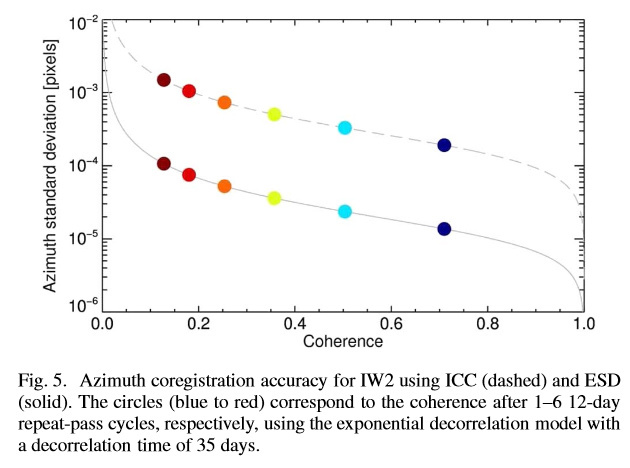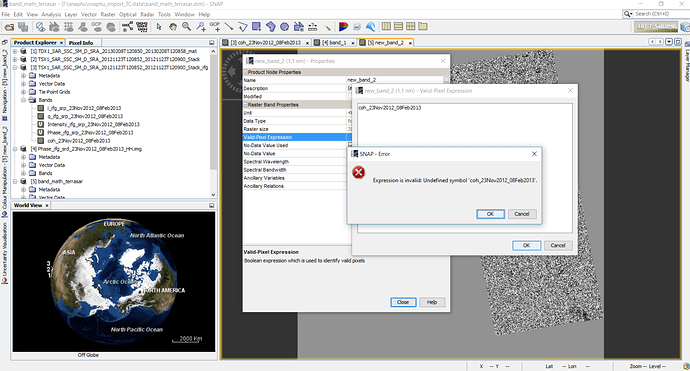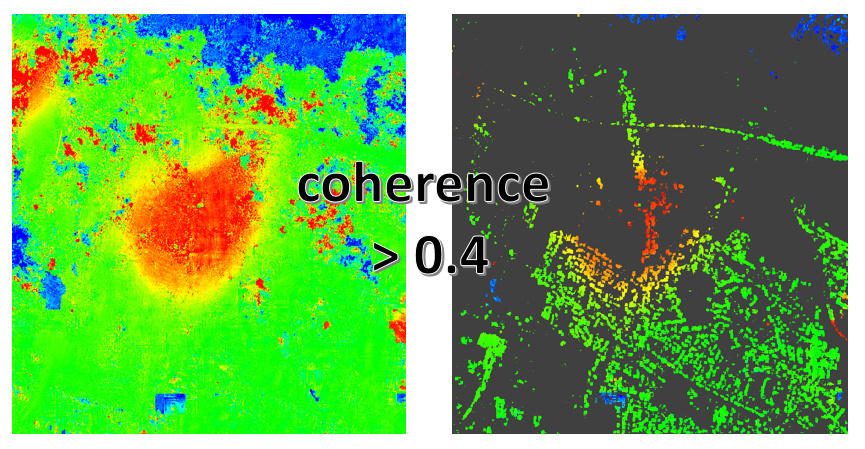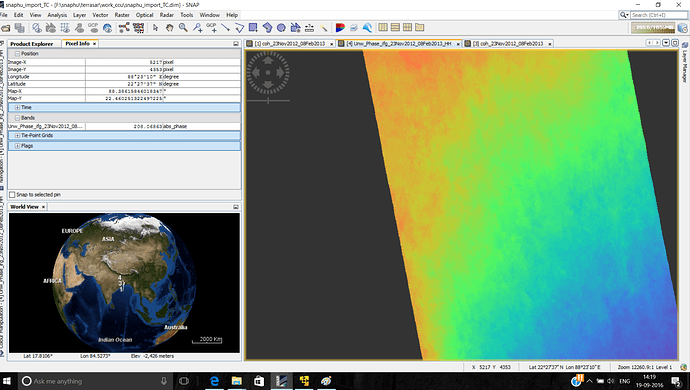in band properties Manu unit of Raster band properties show null … what should I enter here…
you also need to enter the threshold value for the coherence in the valid pixel expression:
coherence... > 0.4 for example
hello ABraun when I enter the coherence file name it shows the error like… “expression is invalid . undefined symbol”… what is it
I explained it in the post above. Just entering the coherence is not a valid logical expression. In this field (valid pixel expression) you define at which locations your result is usable. As coherence is a measure for quality of the interferometric product you only want those pixels at a location where the coherence is larger than a threshold, let’s say 0.4.
Thus, just putting the coherence there is pointless because the expression is lacking a condition. Enter this instead:
coh_23Nov2012_08Feb2013 > 0.4
Then you will have bad quality pixels masked out and only the “good” ones remain.
Depending on your colour scheme it should somehow look like this:
As your temporal baseline is quite long (about 75 days between first and second image) coherence values could be quite small.
Hi @ABraun,
this post and your comments are a very good walk through, thank you all! Is the following quote your experience or are can you recommend literature?
thank you, @heinzollerketchup.
Generally, the longer the temporal baseline (=the time between two images) the higher is the decorrelation which leads to small coherence values. It also depends on the cover of the analyzed surface. Bare ground mostly shows slower decorrelation than one with high vegetation cover.
As you can see here (tested with S1 data), coherence decreases from 0.7 to nearly 0.1 within 6 12-day-cycles (12, 24, 36, 48, 60 and 72 days, blue to red)

Source: http://ieeexplore.ieee.org/stamp/stamp.jsp?arnumber=7390052
Please also have a look at the ESA tutorials:
thanks again, your post just explains my second question. My study area (in Mongolia) and has a low coherence even in a 12 day time gap (mean 0.4). So according to your response this result is influenced by the surface (shrubs, woodland, grasland, bare soil) and not by the time interval.
Is there a possibility to increase the coherence in areas with covered earth surface?
The wavelength of Sentinel-1 is about 5 cm and strongly interacts with smaller vegetation cover such as shrubs. Ich these shrubs slightly change between two image acquisitions coherence rapidly decreases.
It cannot be increased by methods of data processing. Higher coherence can be achieved through precise orbit parameters, shorter time intervals and longer wavelengths (ALOS PALSAR with L-band, ca. 21 cm is less sensitive to smaller surface cover changes).
So all you can do with sentinel is applying the orbit files before your co-registration (also increase the number of GCPs) and hope that the coherence is of better quality.
Ok, I will give it a try.
Thank you!
"Select a point where you assume no change and read the value. Let’s say its 45 cm
Subtract 45 from your imagein order to have zero values at those areas with no change. The remaining variation should be due to subsidence between two overpasses."
can you explain it briefly … you say “45 cm”… from where I get this value for my case… is it from phase or coherence …from coherence map> properties> pixel information tab>band… little confused
this value is hypothetical, it replaces any value you measure at your location where you don’t expect change. You measure it from the unwrapped phase.
ok I understood … but ABraun can you show me procedure of subtraction step wise … that you mentioned
"Subtract 45 from your imagein order to have zero values at those areas with no change. The remaining variation should be due to subsidence between two overpasses:
Assuming that your unwrapped phase is “Unwrapped Phase_ifg_srd_VV_05Dec2008_24Apr2009”
and your reference height is 15:
Right-click on your unwrapped phase open Band maths and enter
Unwrapped Phase_ifg_srd_VV_05Dec2008_24Apr2009 - 15
If the measured value is negative, add it instead.
if you expect no subsidence at this location it means that your subsidence map is 208 mm too high. If there was no change at this pixel there should be a zero. After unwrapping your product a product of relative changes within the raster, given as absolute values (mm in this case if you applied the formula correctly).
So make your raster 208 smaller and you should theoretically have the absolute height changes during the two overpasses.
However, there’s a strong ramp in your image wich distorts the result massively. I don’t think you did anything wrong so far but maybe there’s too much time between your images.
is there any option in sentinel 1 toolbox by which i can get the information of incidence angle of satellite of any radar radar image.
There is the incidence angle tie point grid and also the incidence near and far in the abstracted metadata.
i am trying to unwrapped the phase on VMware … it seems a never ending process… it shows treesize 33876567 , pivots 1376897546, improvements 11567898… what does these term means… is there any way to know how much time it takes…
Going back to the post of Sept. 8-th.
How to find the “incident_angle” in order to process the data?
Is it in the metadata?
hello ABraun
is there any option in sentinel 1 toolbox from where i can get the wavelength information of my terrasar image…


